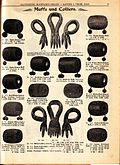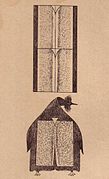Muff (clothes)

A muff (derived from Latin muffula for fur glove ), in Upper German (1793) Stützel , Stutzer , a Schlupfer or Hyrax , also called a Stauch or Stauche r, is a tubular clothing accessory into which the hands are inserted from both sides to keep them warm. As a rule, it is made of fur, less often of fabric or rope. Usually it is also lined with warmth, in the better qualities with a down feather pouch. It either has a loop to be able to hold it in the hand or a long cord with which it can be carried around the neck. Usually a small money pocket is incorporated.
Muffle bags are also produced, bags that do not necessarily have the additional function of muffing. In the 1980s, a small pocket mirror was usually enclosed, possibly with a company imprint on the back.
Barrel-shaped and other rounded sleeves are usually stretched over wooden block molds that the furrier used to have to keep in stock in a wide variety of shapes.

history

Muffe used to be worn by the bourgeoisie and the upper classes instead of gloves . Today they have largely gone out of style. A muff was first mentioned in 1590 in a book about Venetian costumes . In the 17th century it became popular with the higher classes in Germany and France, both men and women. The muff was also called "slip" until the 18th century. In the 19th century the muff became a purely women's accessory .
The muff kept its small shape from around 1860 onwards, occasionally it was flat, but mostly it resembled a roll. From around 1910 onwards it grew again, for a few years to the extent that it had already reached in the 18th century. However, he stayed flat. It is called a pocket muff because you could put a lot in it. The actual combination of Muff and bag Mufftasche , first came to the 1935th
The furrier Wilhelm Schnell, born in 1884, reported from his first years as a journeyman in what is now the Romanian town of Kronstadt : “The little gallantry work that was done looked ugly, the sleeves were only lined with cotton wool. When the manager once showed a Persian muff from Vienna that was fed on down, we almost went mad. When he threw it in a corner and it kept the same shape, we were speechless. In spite of all this, no down bags were purchased, one did not go from the familiar ”.
The Viennese furriers claim the idea of making perfectly shaped sleeves on wooden blocks: “The invention of making sleeves on sticks (Wiener Stockmuff, 1883) is a merit of the local trade and today we can proudly say that the Viennese furrier art can be honored in front of the whole world and when it comes to taste, it comes first ”.
Since around 1890 muff can also be provided with heads and tails of the type of fur used . Around 1910 it was an essential part of the elegant female winter wardrobe, around 1939 the great era of the muff ended with the change in lifestyle due to better heated apartments and closed motor vehicles, fur gloves were a warming but not very decorative substitute.
Not only the muff pocket, but also a simple muff usually has a small pocket, sufficient for a handkerchief. Conveniently, the muff should have a so-called muff holder, a handle with which the muff that is not in use can be comfortably carried in one hand.
The company Keskari , which had utility model protection for muffin bags, had a survey carried out in 1959, taking into account the various income levels and age groups, which chances the muff had on the German market. When asked what speaks against buying a muff, around 47 percent answered “no longer common”, 21 percent said the muff was impractical and 19 percent found it too expensive. 17 percent of the women surveyed had a mustache. However, Muffe were shown again and again in the fashion shows of the great couturiers in the decades that followed.
Herrenmuff, Canton of Zurich
(early 18th century)Margarethe Ludendorff with possum fur muff (1915)
Red Fox Fur Muff (2013)
Season 1900-1901.
Illustrated fashion report from Kastner & Öhler , GrazMuffle bag collection for covering with fur ( Keskari company , before 1940?)
Cut for a muff from the bellows of a great crested grebe (bird species), 1895
See also
Web links
Individual evidence
- ↑ Adelung: Grammatical-Critical Dictionary of High German Dialect . 1793. Last accessed January 5, 2019.
- ^ Mufftaschenspiegel of the former furrier Biel, Bad Hersfeld.
- ↑ Without an author's name: Historisches vom Muff. In: Daily newspaper Der Rauchwarenmarkt No. 81, April 4, 1922, p. 29.
- ↑ Eva Nienholdt: Fur fashions of the 20th century . Chapter VIII of the Series of Articles: Fur in European Clothing. Prehistoric time to the present. In: Das Pelzgewerbe No. 5, 1957, p. 215.
- ^ Wilhelm Schnell: Wilhelm Schnell, Berlin . In: The German fur industry and its associations 1900-1940, attempt at a story . Berlin 1941 Volume 4. Copy of the original manuscript, p. 290 ( → table of contents ).
- ^ Johann Illy: The oldest trade (The development of the furrier art) . In: Yearbook of furriers, tobacco dyers, cap makers and dressers of Austria, 1927 . Publishing house of the cooperative of furriers, tobacco dyers, cap makers and dressers in Vienna, p. 20.
- ↑ Anna Municchi: Ladies in Furs 1900–1940 . Zanfi, Milan 1992, p. 34 ISBN 88-85168-86-8 .
- ^ Francis Weiss: From Adam to Madam . From the original manuscript part 2 (of 2), in the manuscript p. 177 (Eng.)
- ↑ Without information about the author: Ingredients for fur processing . In: Die Kürschnerfibel No. 3, supplement to the Kürschner-Zeitung No. 9, Verlag Alexander Duncker, Leipzig, March 21, 1938, pp. 31–32.
- ↑ Ingeborg Heider: Can the mustard become modern again? In: Die Pelzwirtschaft , No. 10, October 1959, pp. 376–377. A survey by the Institute for Advertising Psychology and Market Research, Frankfurt am Main among 1000 women.










